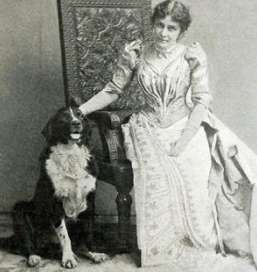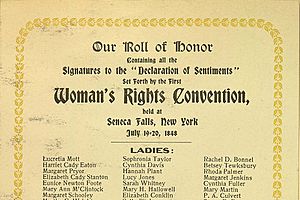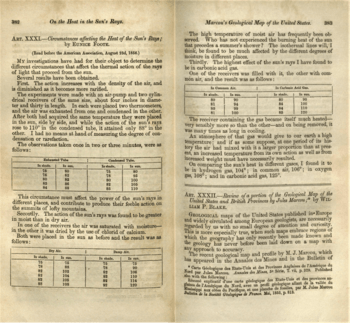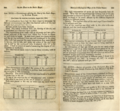Eunice Newton Foote facts for kids
Quick facts for kids
Eunice Newton Foote
|
|
|---|---|
 |
|
| Born |
Eunice Newton
July 17, 1819 |
| Died | September 30, 1888 (aged 69) |
| Resting place | Green-Wood Cemetery, Brooklyn, New York City |
| Education | Troy Female Seminary |
| Known for | Theory of the effect of carbon dioxide gas on atmospheric temperature |
| Spouse(s) | Elisha Foote |
| Children |
|
| Signature | |
Eunice Newton Foote (July 17, 1819 – September 30, 1888) was an amazing American scientist, inventor, and a champion for women's rights. She was the first scientist known to experiment with how sunlight warms different gases. In 1856, she wrote a paper called Circumstances affecting the Heat of the Sun's Rays. In this paper, Foote suggested that changing the amount of carbon dioxide in the air would change Earth's temperature. Even though women could speak at science conferences back then, another scientist named Joseph Henry presented her paper for her.
Contents
Early Life and Education
Eunice Newton Foote was born as Eunice Newton on July 17, 1819. She was born in Goshen, Connecticut. But she grew up in Bloomfield, New York. Her parents were Thirza and Isaac Newton Jr. Her father was a farmer and businessman. He was also a distant relative of the famous scientist Isaac Newton. Eunice had six sisters and five brothers.
Foote went to the Troy Female Seminary from 1836 to 1837. There, she learned about science from Amos Eaton. He was a pioneer in science education. She also studied chemistry and biology at a nearby science college. Students from her seminary were allowed to attend. She was inspired by the books of Almira Hart Lincoln Phelps. Almira was a botany expert and one of the first women in the American Association for the Advancement of Science (AAAS).
Family Life and Marriage
On August 12, 1841, Eunice Newton married Elisha Foote. He was a judge and a mathematician. They lived for a short time in Seneca Falls, New York. Later, they moved to Saratoga, New York.
Eunice Foote was also a talented artist. She was known as "a fine portrait and landscape painter." She and Elisha had a daughter named Mary Foote. Mary grew up to be an artist and writer, just like her mother.
Fighting for Women's Rights

Eunice Foote was an important part of the 1848 Seneca Falls Convention. This was the very first meeting about women's rights. She was on the committee that prepared the event. Foote was also one of the people who signed the convention's Declaration of Sentiments. This declaration was written by Elizabeth Cady Stanton. It asked for women to have the same social status and legal rights as men. This included the right to vote. Foote was one of five women who helped prepare the meeting's notes for publishing.
Eunice Foote was a neighbor and friend of Elizabeth Cady Stanton. Stanton was a leading figure in the women's suffrage movement.
Scientific Discoveries
Understanding the Sun's Heat
Eunice Foote was a scientist who did experiments at home. She studied how sunlight affects different gases. She used simple tools: an air pump, four thermometers, and two glass cylinders. She put two thermometers in each cylinder. Then, she used the air pump to remove air from one cylinder. She compressed air into the other. After they reached the same temperature, she placed both cylinders in the sun. She measured how much their temperature changed. She did this experiment with carbon dioxide (CO2), regular air, and hydrogen.
Foote found that CO2 trapped the most heat. It reached a temperature of 125 °F (52 °C). She wrote that the cylinder with CO2 "became itself much heated." It also took "many times as long in cooling." Thinking about Earth's past, Foote suggested that "An atmosphere of that gas would give to our earth a high temperature." She believed that if Earth's air once had more CO2, it would have been much warmer.
Foote's paper was accepted at the AAAS meeting on August 23, 1856. This meeting was in Albany, New York. It's not clear why, but Foote did not read her own paper. Instead, Joseph Henry from the Smithsonian Institution read it for her. Henry said, "Science was of no country and of no sex." He added that women's roles included "the true."
Foote's paper was published in 1856 in the American Journal of Science and Arts. It was printed right after a paper by her husband, Elisha. However, the AAAS did not include her paper in their yearly publication of meeting notes. Still, summaries of her work appeared in other publications. These included The Annual of Scientific Discovery and Scientific American in 1856. Some European summaries left out her ideas about carbon dioxide and climate. One even named her husband as the author. But Scientific American praised her work. They were impressed that her findings were proven by her experiments. They wrote, "this we are happy to say has been done by a lady.”
Foote's work showed that CO2 and water vapor in the air affected how much sunlight heated things. This might have been the first scientific study to show what we now call greenhouse gases. Three years later, John Tyndall did more detailed research. He showed that gases trap and release infrared heat, not just sunlight. His work is often seen as the start of climate science. He didn't seem to know about Foote's work.
In 1867, Foote also invented a new paper-making machine. This machine made paper that was stronger and smoother. It was also easier to tear evenly.
Later Life and Recognition
Eunice Foote died on September 30, 1888. She was buried in Green-Wood Cemetery in Brooklyn, New York.
Modern Recognition
For a long time, Foote's work was not widely known. In 2010, a retired geologist named Ray Sorenson found her paper. He realized that Foote was the first to suggest a link between carbon dioxide and climate change. He published his findings in 2011.
In 2018, a movie about Foote's life called Eunice was made. Also in 2018, a meeting was held at the University of California, Santa Barbara. It was called Science Knows No Gender: In Search of Eunice Foote. In 2019, the university library had an exhibit honoring her. It highlighted her discovery that "CO2 is uniquely proficient at absorbing and radiating solar heat back to earth." A physicist there called Foote "the Rosa Parks of science."
In 2020, Joseph D. Ortiz and Roland Jackson published an analysis of Foote's 1856 paper. They described her ideas and how she did her experiments. Jackson noted that Foote was an amateur scientist. At that time, women were often kept out of scientific groups. Few European publications mentioned her work. Joseph Henry, who read her paper, did not fully understand its importance. So, her ideas about CO2 and climate did not get much attention back then.
Images for kids
-
The signature page of the Declaration of Sentiments, bearing Foote’s signature on the left
See also
 In Spanish: Eunice Newton Foote para niños
In Spanish: Eunice Newton Foote para niños





